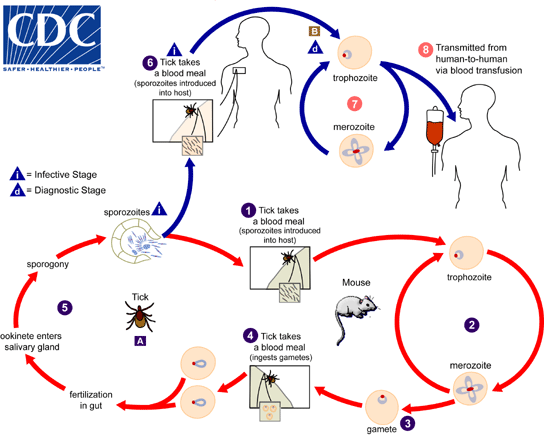HEADLINES: Announcing Galaxy Radar * Effects of the CDC Lyme Disease Reporting Change * Case Study: Atypical Lyme Disease Rash * More, including free CE

Announcing Galaxy Radar
Galaxy Radar is our new format for sharing what we are seeing in the research and publication world. Find out more about what kind of information we collect for you here.
Effects of the CDC Lyme Disease Reporting Change
The CDC has issued a report, Surveillance for Lyme Disease after Implementation of a Revised Case Definition – United States, 2022, which describes the change in case reports after the case definition was changed in 2022. This report has gathered significant press attention, with various reporters gathering more context in their follow-up articles. Reported cases went up 1.7 times after the case definition changed.
The change to require only laboratory evidence for case reports was made to streamline reports from 15 high-incidence jurisdictions. For the rest of the jurisdictions, supporting clinical information is still required. However, there are concerns that requiring the clinical information paperwork may result in under-reporting from those remaining jurisdictions.
Selected additional media report coverage:
Case Study: Atypical Lyme Disease Rash
Atypical Lyme Disease Rash: A Case Report, from S. Khanna and L. J. Goebel at the John C. Edwards School of Medicine in West Virginia, describes a patient with a solid purple rash without an outer ring or central clearing. The patient’s initial complaint was a large rash on her abdomen six days after a tick bite, with smaller rashes continuing up her torso. The open access article provides photos of the rash.
Her ELISA was positive, but her western blot was non-confirmatory, with only IgG P58 antibodies. Both of these tests are serology tests, which look for antibodies. However, antibody tests for Lyme disease are generally unreliable for up to six weeks after infection.
Find out more about direct detection of the bacteria that causes Lyme disease here:
Lyme Borrelia Nanotrap Antigen Test from Galaxy Diagnostics.
In these early cases, identification of signs and symptoms including any rash is required. However, the case report authors collected disappointing statistics related to the ability of clinicians to correctly identify an EM rash:
In a study conducted in 2012 designed to understand the recognition of various appearances of LD by users of the Lyme Disease Research Foundation website, only 20.5% of participants could correctly identify a non-bullseye EM rash, while 72.7% were able to correctly identify the bullseye rash [7]. Study results showed that 25.7% of the participants incorrectly identified the uniformly red EM, 43.6% incorrectly identified the disseminated EM, and 33.0% incorrectly identified the blue-purple EM presentation that was similar to our patient’s rash [7].
The authors point out that correct identification of this kind of rash is also important for identifying Rocky Mountain spotted fever (Rickettsia rickettsia).
The patient was treated with antibiotics and had significant improvement after the first week.

MORE NEWS: Babesia Round Up * Sciencey Science * A One Health Snake Story and AI * March ZOHU Call Free CE * Heart Month * Rare Disease Day
Babesia Round Up
The start of 2024 brought a bumper crop of Babesia publications and pre-prints. Here are a few:
Coinfection of Babesia and Borrelia in the Tick Ixodes ricinus – A Neglected Public Health Issue in Europe?, TGT Jaenson, JS Gray, P-E Lindgren & P Wilhelmsson publishing from Sweden and Ireland – In previously published studies, ticks removed from people and birds have a high rate of coinfection with both Babesia and Borrelia species. However, clinical testing rates for babesiosis in Europe are very low. The authors bring up the possibility of under-diagnosis of babesiosis in the general population, in people with blood transfusions, and in people with complicated Lyme borreliosis and PTLDS.
Expression of sex-specific molecular markers by Babesia bovis gametes, HE Hussein, WC Johnson, NS Taus & MW Ueti at Washington State University – Many articles about the lifecycle of Babesia species state that the male and female gametes are indistinguishable. This article identifies their differences, specifically in B. bovis, a species that infects cattle. As the gametes fuse in the tick vector to produce the sporozoites released into a future host, information about their sexual dimorphism is a foundation for possible disruptions in their reproductive cycle.

Multiomics Analysis Reveals B. MO1 as a Distinct Babesia Species and Provides Insights into its Evolution and Virulence, P Singh et al. from a group of researchers from Yale and other US universities, Spain and Mexico – When a novel species of Babesia started causing severe infections in the US Midwest, it was at first evaluated as closely related to B. divergens, the main cause of babesiosis in Europe. This first complete sequencing of B. MO1 finds unique genetics that may be related to its unique ecological niche.
Transmission Risk Evaluation of Transfusion Blood Containing Low-density Babesia microti, Y Cai et al. publishing from China. In this study, blood from humans and from mice that had B. microti levels below the nested PCR detection level (as determined by these researchers’ testing) was transfused into uninfected mice. The lower infection density resulted in later peak infection in the recipient mice, but infected they were.
Find out more about Babesia infection and Babesia testing available at Galaxy Diagnostics.
More Sciency Science
Pathogenic Rickettsia spp. as Emerging Models for Bacterial Biology, B Sit & RL Lamason at MIT – A popular model bacteria for the laboratory is E. coli; it is predictable and easy to grow – what’s not to love? In contrast, Rickettsia species are diverse, biologically complicated due to their need to survive in both a vector and a host, and a nightmare to grow in the lab. In other words, they are perfect for investigating real-world complications that are likely to apply to many other species. This paper reviews Rickettsia’s contributions as a model bacteria.
Broadly Conserved FlgV Controls Flagellar Assembly and Borrelia burgdorferi Dissemination in Mice (pre-print), M Zamba-Campero et al. at NIH – Flagella are important for propelling bacteria, but they are also a risk to a stealth bacteria as they break off and are recognized by the immune system. B. burgdorferi vary in their presentation of flagella. “Our work defines infection timepoints when spirochete motility is most crucial and implicates FlgV as a broadly distributed structural flagellar component that modulates flagellar assembly.”
Comparative Evaluation of the Efficacy of Two Ectoparasiticides in Preventing the Acquisition of Borrelia burgdorferi by Ixodes scapularis and Ixodes ricinus: A Canine Ex Vivo Model, D Tahir et al. at Université Paris Cité, Ceva Santé Animale & Clinvet Morocco – Researchers created a silicone-based feeding model that incorporates a hair model. This model can be used to test ectoparasiticides for furred animals such as dogs.
The Influence of Growth Time on the Identification of Bartonella henselae Strains by MALDI-TOF Mass Spectrometry, K de Almeida Lins et al. at Universidade Estadual de Campinas in Brazil – Clinical laboratory confirmation of bartonellosis is notoriously difficult. Could the use of mass spectrometry help? In this study of three strains at two time points each, the researchers did not find consistent spectra. They conclude that if this technique were to become useful, it would require a database of growth time results.
A One Health Snake Story and AI
One Health is about following the story that brings together people, animals and the environment in ways that affect the health of all three. In this unique One Health story from the mountains of central Italy, a snake-handling event involving wild snakes from the area occurs every May 1st. JA Mendoza-Roldan et al., from a group publishing from Italy, the US, Germany, Austria and Hong Kong, China, have published their study, Parasites and Microorganisms Associated with the Snakes Collected for the “Festa Dei Serpari” in Cocullo, Italy.
The event is a unique opportunity for a kind of public science initiative in which wild snakes collected for the event can be investigated both to monitor their own health and to benefit the natural conservation of the region, while also investigating the exposures of event participants. Reptiles are an under-appreciated and under-researched host for vector-borne pathogens.
These snakes carried mites as well as a wide variety of microorganisms from genera that include vector-borne pathogens. 28.5% of the snakes carried at least one parasite or microorganism. Their blood and feces also revealed a variety of bacteria that could be transmitted orally by the snake.
One Health programs continue to grow in the United States, this week with the Precision One Health Initiative at the College of Veterinary Medicine at the University of Georgia. This program aims to use AI and machine learning to process the complex stories found in large amounts of One Health Data.
March US CDC Zoonoses & One Health Update (free CE)
Topics:
Relational One Health: A more-than-biomedical approach to more-than-human health
Washington State One Health Needs Assessment
Alpha-Gal Syndrome—Getting to the Meat of It
Wednesday, March 6, 2024, 2-3 pm Eastern time
Heart Month
February is American Heart Month. A reminder to use flea and tick prevention to protect your heart.
Find out more about How Vector-Borne Diseases Impact Heart Health.
Rare Disease Day
Rare Disease Day was February 29th. Although Lyme disease has come off the rare disease list with increases in diagnosis, it is associated with rare disease such as Bell’s palsy. Lyme disease patients continue to benefit from advocacy techniques grown out of the rare disease community. To see advocacy in action and share your story of rare disease, visit: http://www.RareDiseaseDay.org
See past issues:



